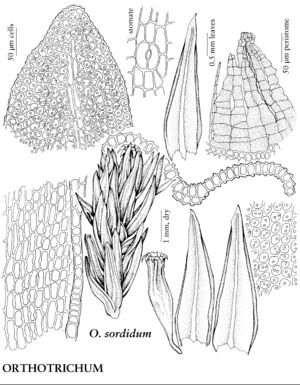Orthotrichum sordidum
in C. F. Austin, Musci Appalach., 168. 1870.
Plants 0.5–3 cm. Stem-leaves loosely erect-appressed and often slightly contorted when dry, narrowly lanceolate to oblong-lanceolate, 2–3.6 mm; margins revolute to near apex, entire; apex acute; basal laminal cells elongate-rectangular, walls thick, nodose; distal cells 7–14 µm, 1-stratose, papillae 2 or 3 per cell, conic, size moderate. Specialized asexual reproduction absent. Sexual condition gonioautoicous. Seta 0.5–1.6 mm. Capsule 1/2–2/3 emergent, sometimes immersed or fully exserted, oblong to oblong-cylindric, 0.8–1.5 mm, strongly 8-ribbed 1/2–2/3 length; stomata superficial; peristome double; prostome rudimentary or absent; exostome teeth 8, reflexed, reticulately papillose to obscurely papillose, deeply perforate, cancellate; endostome segments 8, well developed, usually present when capsule old and dry, narrow, of 1 or 2 rows of cells, smooth or finely verrucose. Calyptra oblong-conic, smooth, sparsely hairy, hairs smooth or papillose. Spores 19–29 µm.
Habitat: Trunks of deciduous and coniferous trees, boulders in hardwood forests, small trees
Elevation: low to moderate elevations (0-1000 m)
Distribution

Man., N.B., Nfld. and Labr., N.W.T., N.S., Ont., P.E.I., Que., Alaska, Maine, Mass., Mich., Minn., N.H., N.J., N.Y., Pa., Vt., Wis., n Asia
Discussion
Orthotrichum sordidum is distinguished by its oblong capsules with exostome teeth perforate almost to the base and cancellate distally. The capsule neck is long and shriveled.
Selected References
None.
Lower Taxa
"/2" is not declared as a valid unit of measurement for this property. "/3" is not declared as a valid unit of measurement for this property.
